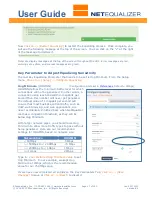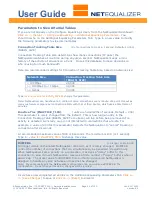
User Guide
APconnections, Inc. // 303.997.1300 // www.netequalizer.com
Page 30 of 120
rev. 20170131
© 2014-2017 APconnections, Inc. All Rights Reserved
version 8.4
Setting up Bandwidth Pools
(
back
)
A Bandwidth Pool (Pool) is a collection of IP addresses that
share
a bandwidth
allocation. The sum total of bandwidth for all of the IP addresses will not be allowed to
exceed more than the total bandwidth allocated to the Pool. For example, if four IP
addresses are assigned to a pool, and the pool download bandwidth limit is set at 10Mbps,
then the total download bandwidth for all four IPs together is 10Mbps (the total, not per IP).
Pools are a bandwidth restriction, not a reservation.
Think of a Pool as a "
virtual NetEqualizer
". You can group users into logical trunks by IP
address and apply
equalizing technology
to each logical group (Pool). Equalizing is
performed in the same fashion as across your entire network trunk; but in this case it
equalizes
within
the Pool. When the total bandwidth threshold for that Pool is reached,
determined by the RATIO parameter, then any large connections (over HOGMIN) associated
with IP addresses within the Pool will be penalized. For our example, if RATIO was 85%,
then equalizing would occur on the 10Mbps Pool when download bandwidth hits 8.5Mbps.
The bandwidth restriction on a Pool may fluctuate a bit depending on the type of traffic.
Heavy use of UDP traffic tends to run over the limit, and heavy TCP/IP traffic (FTP for
example) will tend to be held below the limit.
Pools were added for network topologies where bandwidth congestion is occurring at nodes
in the network, not necessarily at the WAN/LAN connection. For example, this could be
occurring in a wireless network where bandwidth congestion occurs at the wireless hotspots
or in the backhaul connections. Individual bandwidth pools can be defined with the IPs of
users at each hotspot and equalizing applied per hotspot.
One example of using Pools is to accommodate cases where bandwidth is advertised and
sold by Internet Providers as "you are one of n customers sharing x bandwidth". Another
case to use bandwidth pools is to set up equalizing at the subnet level. For example, a
university may split their network into faculty, administrators, and student subnets. Each of
these subnets could be defined as a bandwidth pool, with separate upload/download speeds
that are shared by all users in the pool.
From the NetEqualizer Dashboard or Navigation Menu
Click on ->[Setup] -> Manage Traffic
Limits -> Configure Pools and VLANs ->By Pool tab
. The following screen opens.
















































